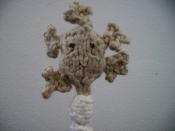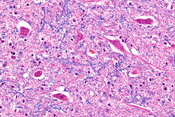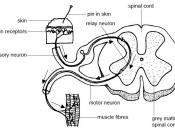Upper motor neurons and lower motor neurons act to carry nerve impulses from the brain out to the muscles in the body.
Upper motor neurons supply input to the lower motor neurons. They do this by either synapsing directly to lower motor neurons, or by synapsing with a local circuit neuron, which then synapses with a lower motor neuron. The upper motor neurons originate in the motor region of the cerebral cortex or brainstem. The neurons from the cerebral cortex are important for planning, initiating, and directing voluntary movements. Neurons from the brainstem help to regulate muscle tone, control postural muscles, and help maintain balance and orientation of the head and body. Upper motor neurons connect the brain to the proper point of the spinal cord, where it can be synapsed and continued by either the local circuit neuron or the lower motor neuron. When the upper motor neuron synapses with the lower motor neuron, the neurotransmitter glutamate is used.
This neurotransmitter is identified by the glutamatergic receptors.
Lower motor neurons help to connect the brainstem and spinal cord to the actual muscle fibres. They have their cell bodies in the brain stem and the spinal cord, and their axons extend from the motor nuclei of the cranial nerves to skeletal muscles. These motor neurons synapse with the upper motor neurons, carrying on the nerve impulses that the upper motor neurons are carrying.
Motor neurons descend the spinal cord in tracts. These tracts are for the conduction of nerve impulses. The sensory tracts ascend towards the brain, and the motor tracts descend, to the rest of the body. The tracts are named for their position and their direction of signal. Examples of motor tracts are the pyramidal (corticospinal) tract, and the extrapyramidal tract.
An example of an upper...


